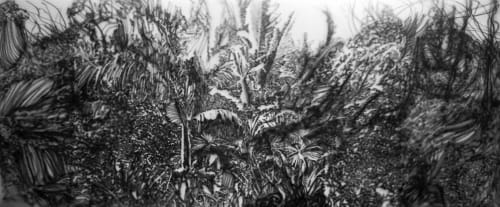Life, Death and Rebirth: Høyersten Contemporary, Bergen, Norway
Eamon O’Kane, Roald Andersen, Linda Soh Trengereid, Marcus Soddano, Jan Freuchen, Søren Sejr, Maya Stefania Wibling, David A. Rios, Aurora Solberg
Curatorial text by Erlend G. Aalbæk Høyersten
The story goes that before the discovery of the fabulous brightness of burning sperm whale oil, people in Northern Europe slept in two phases a night. The whale oil gave the oil lamps ten times more power or light than previous oils and tallow candles, and extended the length of the day, social life, and chores. It was one of the beginnings of our modern life. Before the discovery towards the end of the 1700s, people went to bed when night subsided, slept four hours, woke up again for a few hours around midnight, wandered around in the dark, looked to animals, people, houses and more, loved, ate, and talked, before going to bed to dream again until dawn. One night, two phases. With the new light, the darkness gave way, and we began to sleep, and perhaps dream, in a different way.
The darkness has always seemed terrifying. There, evil lurks in the form of trolls and goblins, monsters, demons, and - humans. In the dark, all cats are grey, and during the day the sun creates life and growth and colour. Back then, the white light of whale oil gave colour to the darkness and animated the night in a way that the yellow sebum light had never managed. But even though the night has become light, we are still afraid of the dark. Perhaps because it reminds us of death, the Great Sleep. Although most of us deny aging, old age and death as something absolute, in solitude, in dark times, when everything goes against us and seems hopeless, we can become extra frightened of our common end. The fear of death, however, is perhaps mostly about the fear of not having lived the way we have been taught that we should live, after all. And then we get scared to live, when we try, because maybe we are living life the wrong way.
Western art history is overflowing with fear and anxiety, but also hope and faith, with “memento mori” and “carpe diem”, reminders and revelations. Before, art taught us teachings, now artists give us, as co-creators, the opportunity to see ourselves, the world and the knowledge, empathy, and emotions we possess, with newly acquired perspectives and at new angles. Art thus has the potential to remind us of what it means to be human in all its cruelty, boredom, and grandeur. When we encounter art, we are also reminded that we are not alone in being human.
Life is a long journey of discovery in metamorphosis and transformation, physically and mentally. Sometimes for the worse, sometimes for the better. Cells divide and at some point, they stop renewing themselves, and gravity inexorably pulls us towards Earth. We cannot change gravity, but we can choose to be who we want to be, for ourselves and others and those who come afterwards. A physical birth is difficult by nature, a mental rebirth can also be so. Nevertheless, we often forget that we are reborn time and time again, perhaps without giving it a second thought, when one finds one’s love, has children, chooses a new chapter or other track in one’s career, emerges stronger from a trauma, or when one encounters people who enrich the foundation of life. It is also the premise in the world of art, the eternal rebirth. The struggle for existence and man’s search for meaning are equal to art’s right to exist; It is only relevant if it is reinvented, reborn, and created repeatedly. Understanding art is about putting it in different contexts, not only the closest one, ourselves, but also considering what has been. And by looking at the present in the light of the past, we may get a sense of what may become.
All participating artists in this exhibition have been chosen, not only on the basis of the high quality of their oeuvre, but because they each express in their own way what it is like for them to be human, and how through art they discover, rediscover, play, process, try to understand, collect fragments, investigate and wonder at themselves, close relationships, and the people in the world, and not just the art world’s own discussions.
The Danish philosopher Søren Kierkegaard (1813-1855) wrote that life is something that must be lived forward but can only be understood backwards. We no longer live on the same scale as before, following the rise and fall of the sun, the repetition of the seasons, but by the clocks and calendar’s linear understanding of the world. If we stop seeing life as something lined up but understand it circularly or as a series of eras and cycles, rebirth also becomes an opportunity that is life-giving, for what has been and what is to come. Alpha and omega. Life, death and rebirth.
Høyersten Contemporary
Inger Bang Lunds vei 16, Bergen
After April 28th: Tuesday to Friday 11-17 / Saturday 11-15 / Or by appointment

